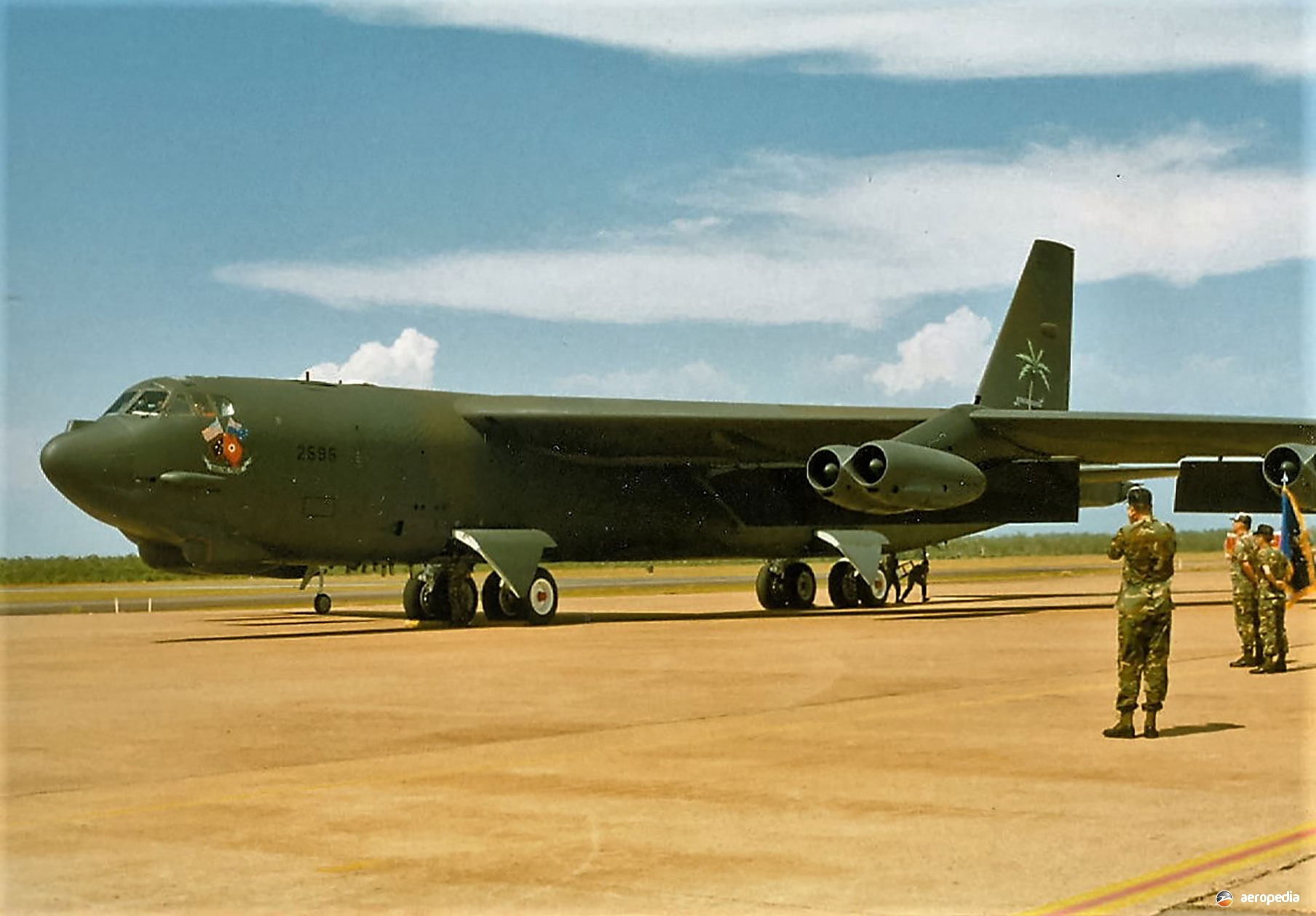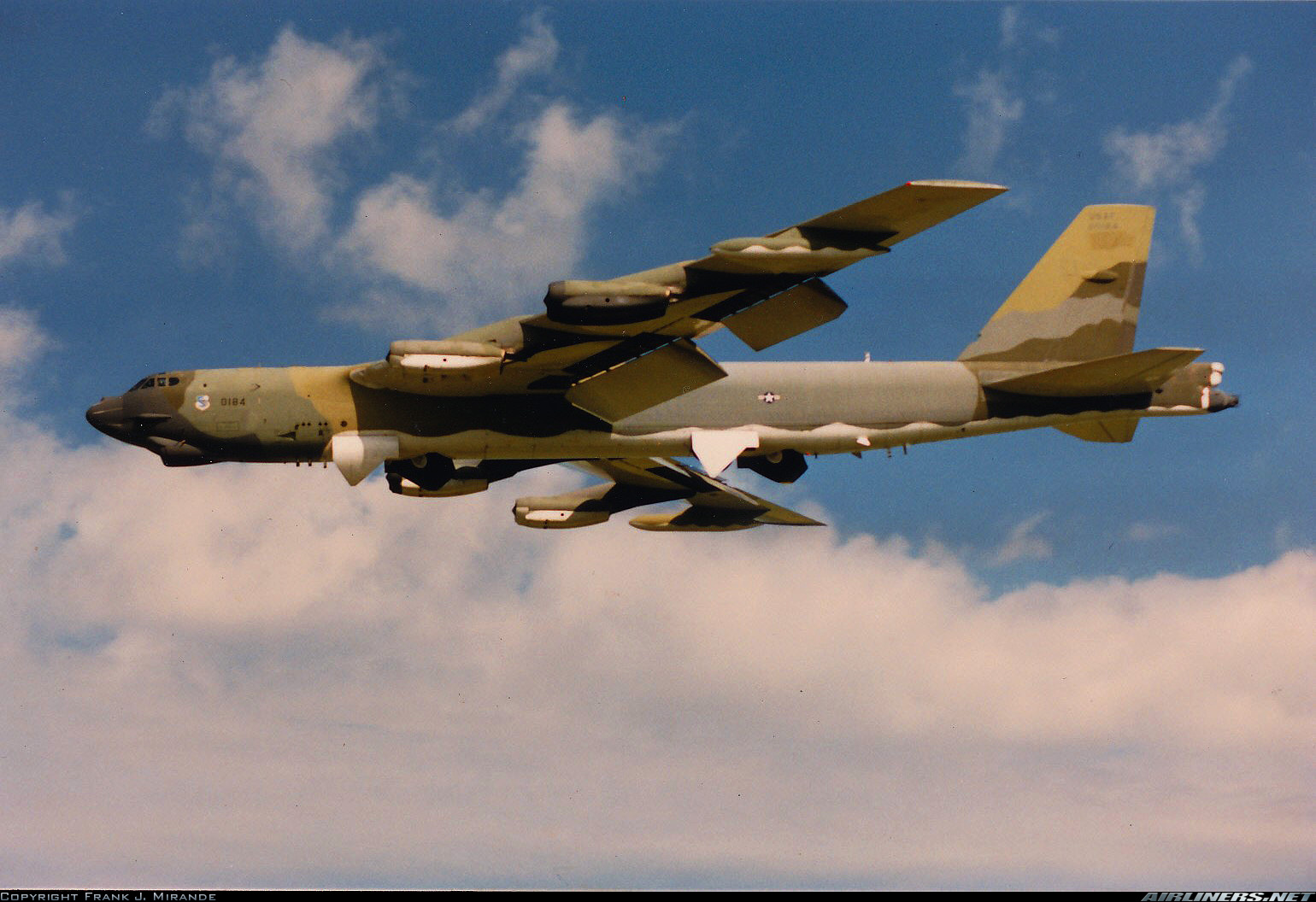Boeing B52G Stratofortress USA Air Force Aviation Photo 0827969

Boeing B52G Stratofortress USA Air Force Aviation Photo 0651008
B-52 Stratofortress. Intercontinental Strategic Bomber. DESCRIPTION: The B-52 began life in 1948 as a replacement for the B-50 Superfortress and eventually the B-36 Peacemaker bombers. The original B-52 concept was to be powered by turboprops owing to their much lower fuel consumption when compared to early turbojet engines.

Boeing B52G Stratofortress USA Air Force Aviation Photo 0057006
B-52G. 'Stratofortress'. Notes: Upgraded B-52F. Fin span reduced, ailerons deleted, nose radome enlarged. A Boeing B-52G made a record flight around the US, covering 9,000 non-refueled miles in 18 hours 30 minutes. I worked on the B-52G DFCS at Travis AFB from 1963 to 1966. Years later while working in the telecom I came across an old friend 58.

Boeing B52G Stratofortress USA Air Force Aviation Photo 2656131
The Boeing B-52 Stratofortress is an American long-range, subsonic, jet-powered strategic bomber. The B-52 was designed and built by Boeing, which has continued to provide support and upgrades. It has been operated by the United States Air Force (USAF) since the 1950s.
.jpg)
Boeing B52 Stratofortress Wikiwand
The People Behind the B-52. We bring together all those who have been or are associated with the BUF—designers and builders, aircrew, maintainers, enthusiasts — to exchange memories. We try to help old buddies find each other -- anything it takes to keep alive the history of the weapon known in its early days as "America's Long Rifle.".

Boeing B52G Stratofortress USA Air Force Aviation Photo 0246809
Seventy years since its first flight, the Boeing B-52 Stratofortress remains, remarkably, very much at the top of its game, as one of the U.S. Air Force's three strategic bombers, and is still.

BOEING B52 STRATOFORTRESS · The Encyclopedia of Aircraft David C.
The B-52H Stratofortress is a long-range, heavy bomber that can perform a variety of missions. The bomber is capable of flying at high subsonic speeds at altitudes of up to 50,000 feet (15,166.6 meters). It can carry nuclear or precision guided conventional ordnance with worldwide precision navigation capability. Features

Boeing B52G Stratofortress USA Air Force Aviation Photo 1508614
The Boeing B-52 Stratofortress, in service today, almost seventy years after its first test flight, is one of the most versatile and successful aircraft ever designed.

Boeing B52G Stratofortress USA Air Force Aviation Photo 0027729
The B-52 Stratofortress is a long-range, heavy bomber that can perform a variety of missions. The bomber is capable of flying at high subsonic speeds at altitudes up to 50,000 feet. Pictured: A B-52 Stratofortress assigned to the 2nd Bomb Wing at Barksdale Air Force Base, Louisiana, flies over Andersen Air Force Base, Guam, in support of a Bomber Task Force deployment, October 20, 2023.

Boeing B52G Stratofortress USA Air Force Aviation Photo 1416832
Specifications: Wingspan: 56.38 m (185 ft) Length: 48.06 m (157 ft 7 in) Height: 12.43 m (40 ft 8 in) Wing area: 371.6 m² (4,000 sq ft) Max speed: 1,014 km/h (630 mph) Cruising speed: 909 km/h (565 mph) Service ceiling: 18,288 m (60,000 ft) Range: 20,116 km (12,500 miles) Empty weight: 100,407 kg (221,357 lb) Loaded weight: 221,116 kg (488,000 lb)

Boeing B52G Stratofortress USA Air Force Aviation Photo 0318190
The B-52G introduced a shorter vertical tail and numerous internal changes, including a new integral-tank wing with internal fuel capacity increased to 46,576 U.S. gallons and with external drop tanks reduced in volume to 700 U.S. gallons each.. A B-52 Stratofortress from the 2nd Bomb Wing, Barksdale Air Force Base, La., receives fuel from a.

Boeing B52G Stratofortress USA Air Force Aviation Photo 0315423
The Boeing B-52 Stratofortress was developed and manufactured by Boeing as a long-range, subsonic, strategic bomber that can carry a maximum of 32,000 kg of weapons with a particular combat range of above 7,600 nautical miles without aerial refueling. Since 1950, the jet-powered bomber has served the United States Air Force. The B-52 was produced from 1952 to 1962.

Boeing B52G Stratofortress USA Air Force Aviation Photo 0484774
The Last Flight of Hobo 28. On January 21, 1968, the crew of a Boeing B-52G like this ejected over Greenland after a fire broke out in their bomber. (© Boeing) In one of America's worst "Broken Arrow" incidents, a B-52 carrying four hydrogen bombs crashed on the ice off Greenland. Major Alfred D'Amario thought the worst was over after.

Boeing B52G Stratofortress USA Air Force Aviation Photo 0827969
The B-52 Stratofortress is a large, long-range heavy bomber that was first introduced in 1955. It is a four-engine, long-range strategic bomber operated by the United States Air Force and its primary missions are conventional bombing, and conventional and nuclear missions.

B52G Stratofortress
Boeing B-52 Stratofortress, a U.S. high-altitude bomber, dropping a stream of bombs over Vietnam. The B-52 has a wingspan of 185 feet (56 metres) and a length of 160 feet 10.9 inches (49 metres). It is powered by eight jet engines mounted under the wings in four twin pods.

Boeing B52G Stratofortress USA Air Force Aviation Photo 0663482
One of the most recognizable aircraft in the world and an icon of the United States' Cold War deterrent, the B-52 Stratofortress was for decades the U.S. Air Force's primary strategic nuclear.

Boeing B52G Stratofortress USA Air Force Aviation Photo 2787745
The Boeing B-52 Stratofortress is one of the cold war era deadly weapons operated by the USAF (United States Air Force). The subsonic, jet-powered, long range strategic bomber was introduced by USAF in February 1955 and is still in service. It is capable of carrying up to 32,000 kg or 70,000 pounds of weapons and was built to carry the cold war.